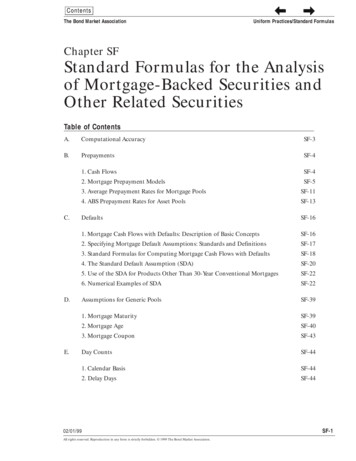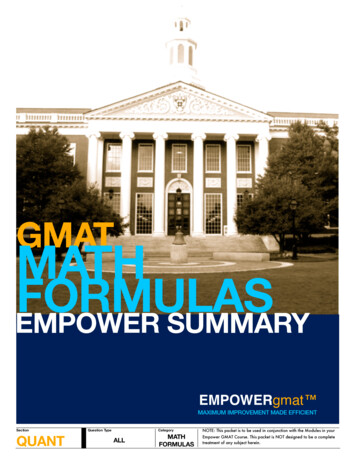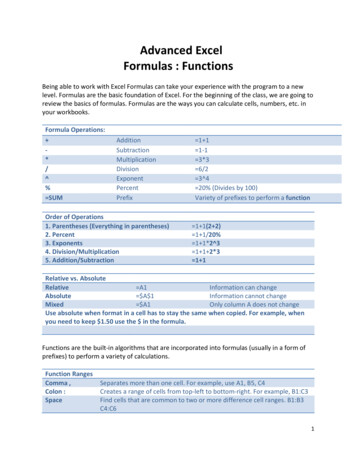
Transcription
ContentsThe Bond Market AssociationPrevNextUniform Practices/Standard FormulasChapter SFStandard Formulas for the Analysisof Mortgage-Backed Securities andOther Related SecuritiesTable of ContentsA.Computational AccuracySF-3B.PrepaymentsSF-41. Cash FlowsSF-42. Mortgage Prepayment ModelsSF-5C.D.E.3. Average Prepayment Rates for Mortgage PoolsSF-114. ABS Prepayment Rates for Asset PoolsSF-13DefaultsSF-161. Mortgage Cash Flows with Defaults: Description of Basic ConceptsSF-162. Specifying Mortgage Default Assumptions: Standards and DefinitionsSF-173. Standard Formulas for Computing Mortgage Cash Flows with DefaultsSF-184. The Standard Default Assumption (SDA)SF-205. Use of the SDA for Products Other Than 30-Year Conventional MortgagesSF-226. Numerical Examples of SDASF-22Assumptions for Generic PoolsSF-391. Mortgage MaturitySF-392. Mortgage AgeSF-403. Mortgage CouponSF-43Day CountsSF-441. Calendar BasisSF-442. Delay DaysSF-4402/01/99All rights reserved. Reproduction in any form is strictly forbidden. 1999 The Bond Market Association.SF-1
ContentsThe Bond Market AssociationF.G.H.PrevNextUniform Practices/Standard FormulasSettlement-Based CalculationsSF-451. General RulesSF-452. CMO Bonds with Unknown Settlement FactorsSF-463. Freddie Mac Multiclass PCs (REMICs)SF-47Yield and Yield-Related MeasuresSF-481. General RulesSF-482. Calculations for Floating-Rate MBSSF-523. Putable Project LoansSF-55Accrual InstrumentsSF-561. Average Life of Accrual InstrumentsSF-562. Accrual Calculations for CMO Z-BondsSF-5702/01/99All rights reserved. Reproduction in any form is strictly forbidden. 1999 The Bond Market Association.SF-2
ContentsThe Bond Market AssociationPrevNextUniform Practices/Standard FormulasA. Computational AccuracyMany common calculations for mortgage-related securities (yields, durations, prepayment rates,etc.) require the calculation of a large number of intermediate quantities (cash flows, principalbalances, etc.). All intermediate calculations should be carried out to their full precision, preserving at least ten significant digits of accuracy. This will generally require double-precision computer arithmetic. The only quantities that should be assigned an integer variable type are thosethat represent whole numbers of days, months or years.Only when all computations are complete should the final values be rounded for display. Resultsmay be shown to any desired number of decimal places, provided that the last digit presented hasbeen obtained by rounding and not by truncating the complete figure.The numerical examples that appear throughout the document are intended to provide simplechecks against improper implementation of the Standard Formulas, not an exhaustive set ofbenchmarks that would guarantee conformance.02/01/99All rights reserved. Reproduction in any form is strictly forbidden. 1999 The Bond Market Association.SF-3
ContentsPrevThe Bond Market AssociationNextUniform Practices/Standard FormulasB. Prepayments1. Cash FlowsFor a level-payment fixed-rate mortgage pool with gross weighted-average coupon C%, current weighted-average remaining term M months, and M0-M months elapsed since origination, the amortized loan balance (as a fraction of par) isBAL 1 – (1 C 1200)1 – (1 C 1200) M M 0and the scheduled gross monthly payment (also as a fraction of par) isGROSS MORTGAGE PAYMENT PRINCIPAL INTEREST ( BAL1 BAL 2 ) ( BAL1 * C 1200) C 12001 – (1 C 1200) M 0 .The net payment passed through to investors consists of the scheduled gross payment above,plus unscheduled prepayments, minus a servicing fee of BAL1 * S/1200, where the servicingpercentage (S) is the difference between the gross coupon (C) and the net pass-throughcoupon of the security.The pool factor (F) expresses the principal remaining in the pool each month as a fraction ofthe original face amount. The survival factor (F/BAL) represents the fraction of 1.00 unitloans remaining in the pool from those originally present at issuance:POOL FACTOR SURVIVAL FACTOR * AMORTIZED LOAN BALANCE.By convention, mortgage-related security analysis assumes that all prepayments are wholeprepayments on 1.00 unit loans within the pool.The cash flows of more complex mortgage securities (CMO bonds, Graduated-PaymentMortgages, Adjustable-Rate Mortgages, etc.) are governed by specific contractual featuresnot addressed here.Example: A mortgage pass-through is issued with a net coupon of 9.0%, a gross coupon of9.5% and a term of 360 months. If prepayments for the first month are 0.00025022 (as afraction of par), then the first cash flow paid to investors will consist of the followingcomponents:(1) Scheduled Amortization 0.00049188,(2) Unscheduled Prepayments 0.00025022,(3) Gross Mortgage Interest 0.00791667,(4) Servicing Fee 0.00041667,02/01/99All rights reserved. Reproduction in any form is strictly forbidden. 1999 The Bond Market Association.SF-4
ContentsPrevThe Bond Market AssociationPass-Through PrincipalUniform Practices/Standard Formulas Pass-Through Interest Pass-Through Cash FlowNext (1) (2)0.00074210,(3) – (4)0.00750000,(1) (2) (3) – (4)0.00824210.2. Mortgage Prepayment ModelsThe prepayment rate of a mortgage pool may be expressed in a number of different ways.These measures are equally valid, although a particular method may be more useful in agiven instance.a.The SMM (Single Monthly Mortality) rate of a mortgage pool is the percentage of themortgage loans outstanding at the beginning of a month assumed to terminate duringthe month. That is, if in some month the initial and final pool factors are F1 and F2,respectively (as fractions of the original face amount), and the amortized loan balancesare BAL1 and BAL2 (as fractions of par), then BAL 2 SMM F2 F1 * * 1 100 . BAL1 An equivalent means of specifying a one-month prepayment rate is to separate the factor drop for the month (F1–F2) into scheduled and unscheduled principal payments. Ifthere were no unscheduled prepayments during the month, then the factor for the endof the month would have beenFsched F1BAL 2BAL1 .The quantity F1–Fsched represents amortization for the month, and Fsched–F2 representsearly prepayment of principal. The one-month prepayment rate can then be defined asSMM 100Fsched F2Fsched .02/01/99All rights reserved. Reproduction in any form is strictly forbidden. 1999 The Bond Market Association.SF-5
ContentsPrevThe Bond Market Associationb.NextUniform Practices/Standard FormulasThe CPR (Conditional Prepayment Rate or Constant Prepayment Rate) model is similarto SMM, except that it expresses the prepayment percentage as an annually compounded rate:12CPR SMM 1 – 1 100 100 .The terms “CPR” and “Monthly CPR” have sometimes been used to express prepaymentrates on a monthly basis equivalent to the SMM. This is not recommended, and in thepresent document, “CPR” will refer exclusively to the annualized prepayment ratedefined in the equation above.c.The Standard Prepayment Model of The Bond Market Association specifies a prepaymentpercentage for each month in the life of the underlying mortgages, expressed on anannualized basis. Thus, 100% PSA (Prepayment Speed Assumptions) assumes prepayment rates of 0.2% CPR in the first month following origination of the mortgage loans(not the pool) and an additional 0.2% CPR in each succeeding month until the 30thmonth. In the 30th month and beyond, 100% PSA assumes a fixed annual prepaymentrate of 6.0% CPR. To calculate the prepayment rate for any specific multiple of PSA,adjust the annual prepayment rate at 100% PSA by that multiple. (For example, 200%PSA assumes prepayment rates equal to twice the CPRs from the 100% PSA model, on apool-by-pool basis.) In general, PSA CPR min * 0.2 * max 1,min {MONTH, 30} , 100 , 100 {}where MONTH refers to the accrual period during which the age of the mortgage loansincreases from MONTH – 1 to MONTH. If the loan age is computed as zero subsequentto pool-issue date, then for the purposes of the PSA calculations, MONTH equals 1 forall prior months. In the case of Freddie Mac and Fannie Mae pools with “same-month”loan concentrations greater than 50%, MONTH would equal 1 for the first two monthsof the pool. For Freddie Macs, these pools are identified by the WALA remaining at 0 forthe first two months of the pool. For Fannie Maes, these pools are identified by the original WAM being one month greater than the original loan term for a given pool type.For example, an original WAM of 361 would be reported for a “CL” pool that has anoriginal loan term of 360 months.These CPRs can then be converted into SMMs according to the formula from part (b.)above.02/01/99All rights reserved. Reproduction in any form is strictly forbidden. 1999 The Bond Market Association.SF-6
ContentsPrevThe Bond Market AssociationNextUniform Practices/Standard FormulasFor expositional purposes, AGE is defined as a point in time, whereas MONTH isdefined as a span of time. Pool factors therefore are reported as of an AGE whereasprepayment rates are reported for a MONTH. When a mortgage loan is originated,AGE 0. After MONTH 1, AGE 1. The diagram below illustrates the distinction.Month 1Age: 0Month 21Month 32Month 43. . .4. . .Mortgages in their first 30 months are commonly referred to as “new”; mortgages olderthan 30 months are considered “seasoned.”If the prepayment rate resulting from any of these calculations is either negative orunusually large, then there may be an error in one or both of the pool factors, or possibly in the coupon rate or term to maturity assumed for amortizing the mortgage balance. Such results must be taken with caution.Example: Suppose that for a Ginnie Mae I 9.0% pass-through issued 3/1/88 with aremaining term of 359 months, the 6/1/89 and 7/1/89 pool factors wereF1 0.85150625andF2 0.84732282 ,respectively. How would one compute the prepayment speed for 6/89 using PSA?The amortized loan balance wasBAL1 1 (1 9.5 1200)1 (1 9.5 1200) 344 359 0.99213300on 6/1/89, and wasBAL 2 1 (1 9.5 1200)1 (1 9.5 1200) 343 359 0.99157471on 7/1/89, so with no June prepayments the 7/1/89 pool factor would have beenFsched F1BAL 2 0.85102709.BAL102/01/99All rights reserved. Reproduction in any form is strictly forbidden. 1999 The Bond Market Association.SF-7
ContentsPrevThe Bond Market AssociationNextUniform Practices/Standard FormulasThis allows us to calculateAmortization F1 Fsched 0.00047916,Prepayments Fsched F2 0.00370427,SMM 1000.00370427 0.435270%,0.85102709 SMM 12 CPR 100 1 1 5.1000%.100 With respect to the underlying 360-month mortgages, 2/88 was month 1, so 6/89 countsas month 17. Therefore,PSA 100 *CPR 150.00%.min {0.2 * MONTH 6.0}02/01/99All rights reserved. Reproduction in any form is strictly forbidden. 1999 The Bond Market Association.SF-8
ContentsNextPrevThe Bond Market AssociationUniform Practices/Standard FormulasPrepayment Rate Conversion 8112211261129SMM – Single Monthly Mortality (monthly prepayment rate in percent)CPR – Conditional Prepayment Rate (annual prepayment rate in percent)PSA – Standard Prepayment Model of The Bond Market Association (percentage of PSA [Prepayment Speed Assumption] model: 100% 6% CPR)*PSA CONVERSION IS ONLY VALID AFTER THE 29TH MONTH OF MORTGAGE LIFE.02/01/99All rights reserved. Reproduction in any form is strictly forbidden. 1999 The Bond Market Association.SF-9
ContentsNextPrevConversion of One-Month PSA to SMM Based on Months after Mortgage .936.276.616.977.35SF-10Find the column corresponding to the ONE-MONTH PSA, and the row corresponding to the number of months after origination of the underlying mortgages.The intersection of column and row gives the one-month equivalent SMM.Do not use this table for 3-month, 1-year, or to-date PSA, as results will be inaccurate.Results will be imprecise to the extent that mortgages in a pool have differing ages.Uniform Practices/Standard 627282930PSA:50The Bond Market Association02/01/99All rights reserved. Reproduction in any form is strictly forbidden. 1999 The Bond Market Association.MonthsAfterOrigination
ContentsThe Bond Market AssociationPrevNextUniform Practices/Standard Formulas3. Average Prepayment Rates for Mortgage PoolsOften it is necessary to calculate an average prepayment rate for a single mortgage pool or anaggregation of pools (such as those backing a particular CMO) over a specific historical period.* Regardless of which particular prepayment model is chosen, the proper speed is thatwhich, if applied separately to the underlying mortgages over the entire period, would resultin the actual aggregate balance recorded at the end of the period. Pools which were not present at the start of the period should be excluded from the calculation entirely, as should anypools with incorrect or missing factors at the start or end of the period.**For certain security types, including many CMOs backed by classes of two or more otherCMOs, and many whole loan pass-throughs with principal/interest stripping, the cash flowsand principal balances are not derived from pro rata shares of mortgage pass-throughs, andno single prepayment rate or aggregate balance is sufficient to characterize the security cashflows. In these cases, it is generally not meaningful to define an average prepayment rate, andnone should be reported. Instead, the average prepayment rate for each underlying CMOclass should be reported individually, or if not practical, then summarized together as a range(lowest and highest).Unless otherwise specified, amortization of updated fixed-rate mortgage pools should bebased exclusively on the most recent weighted average maturity information (WAM orWARM) and prepayment calculations on the most recent weighted average loan age (WALA)information provided by the issuer or guarantor at the time the calculation is performed.(See Section D.) Thus, it is not necessary to save prior information for these pools onceupdated values become available, nor is it necessary to recompute previously calculated prepayment rates. This method, while computationally simple, will produce different results forthe same time period when calculations are made at different times. Thus, the January 1991PSA rate for a pool may be different when calculated in February 1992 than when first computed in February 1991, because the WAM and/or the WALA may not have decreased and/orincreased, respectively, by exactly 12 months. Individual firms may use either method toreport historical prepayment rates. This decision affects only calculations of historical prepayment rates; projected cash flows, yields, average lives, and other measures are not affected,since forward projections always use the most recently available data.For certain security types, such as Fannie Mae Trust strips and Megapools, multiple passthrough pools are actually combined into a new pass-through security (an aggregate pool forwhich the issuer reports monthly factors). Even in these cases, historical and projected prepayments should be calculated on the basis of the most detailed pool information availablefor the underlying mortgages.* For a mortgage security (including but not limited to CMOs, REMICs, Megapools and strips), the phrase “prepayment rate sinceissue” can refer to the time since issuance of either the underlying pass-through pools or the mortgage security itself. Market participants should therefore distinguish between “prepayment rate since pool issue” and “prepayment rate since deal issue.” The precisewording is left to the user’s discretion, so long as the intent is clear.** Note that an aggregate calculation for “prepayment rate since pool issue” generally does not refer to a historical period with a uniformstarting date. Therefore, the only pools that should be excluded from this particular calculation are those with incorrect or missingfactors at the end of the period.02/01/99All rights reserved. Reproduction in any form is strictly forbidden. 1999 The Bond Market Association.SF-11
ContentsPrevThe Bond Market AssociationNextUniform Practices/Standard FormulasWith the Standard Prepayment Model, these calculations will generally require an iterativetrial-and-error procedure, even for a single pool; the aggregate PSA speed should not becomputed as a weighted average of individual pool speeds. Likewise, it is generally not accurate to apply an average prepayment speed to a hypothetical single pool having the aggregateWAC and WAM of the pools to be analyzed. At best, these calculations can provide a firstiteration toward the correct value. Average prepayment rates that do not meet the precisespecifications of the preceding paragraphs should be acknowledged as nonstandard approximations.Iteration is not necessary for computing average prepayment rates in terms of SMM or CPR.Instead, one should sum the scheduled balances for the loans at the end of the period, computed as if there were no prepayments during the period. The average prepayment rate forthe aggregation is thenSMM avg1 FINAL AGGREG. BAL actual months in period 100 1 – FINAL AGGREG. BAL sched ,orCPR avg12 months in period FINALAGGREG.BAL actual 100 1 – FINAL AGGREG. BAL sched .Finally, for the special case in which all the mortgages in the sample being considered arefully seasoned at the start of the period, even the aggregate PSA speed can be computedwithout iteration:PSA avg 100 *CPR avg6.0.Example: Consider two Ginnie Mae I 9.0% pass-throughs with the following characteristics:Pool 1Pool 2Original Face: 1,000,000 2,000,000Original Remaining Term:358 mo360 moOrigination Date:4/1/8812/1/881/1/89 Factor:0.869252180.999508127/1/89 Factor:0.847322820.9829023002/01/99All rights reserved. Reproduction in any form is strictly forbidden. 1999 The Bond Market Association.SF-12
ContentsPrevThe Bond Market AssociationNextUniform Practices/Standard FormulasTo determine the average prepayment rate of the two pools over the first six months of 1989, firstcompute the actual final balance,1,000,000 (0.84732282) 2,000,000 (0.98290230) 2,813,127.42 ,and the scheduled final balance,1,000,000 (0.86925218) 2,000,000 (0.99950812)1 – (1 9.5 1200)–3431 – (1 9.5 1200)–3491 – (1 9.5 1200)–353 2,859, 330.23.1 – (1 9.5 1200)–359Then,SMM avgCPR avg1 2,813,127.42 6 100 1 – 2,859, 330.23 0.271142% , 12 2,813,127.42 6 100 1 – 3.2056% , 2,859, 330.23 and, by iterative trial-and-error,PSA avg 212.02% .4. ABS Prepayment Rates for Asset PoolsThe ABS model defines an increasing sequence of monthly prepayment rates (SMM, the percentageof remaining loans that prepay each month), which corresponds to a constant absolute level of loanprepayments in all future periods. For a pool of new loans, the SMM sequence for X% ABS is equivalent to the prepayment each month of X% of the loans originally in the pool. For a pool of seasonedloans, however, this interpretation of the SMM sequence is generally not valid. To avoid possible confusion, the ABS speed and the age of the underlying loans (not the pool) should always be converteddirectly into a sequence of SMM rates according to the formulaSMM 100 * ABS100 – ABS * ( MONTH –1).02/01/99All rights reserved. Reproduction in any form is strictly forbidden. 1999 The Bond Market Association.SF-13
ContentsPrevThe Bond Market AssociationNextUniform Practices/Standard FormulasIf desired, one can then convert these SMM rates into CPR or PSA according to the usualformulas. (See Section B.2.)For purposes of describing an empirical prepayment pattern over a selected historical period,the appropriate ABS speed is the one whose monthly prepayment rates give the correctcumulative paydown for the period. The following formula provides the correct historicalABS speed for any time interval in which the loan age, pool factor and amortized loan balance (as a fraction of par) changed from AGE1, F1, BAL1 to AGE2, F2, BAL2:ABS 100(F F ) ( BAL BAL )AGE ( F F ) AGE ( BAL BAL ).2121211212The size of the pool at origination is not required. BAL may be calculated as in Section B.1.Example: For a pool of 36-month car loans issued 1/1/89 with an original WAM of 34months, a prepayment speed of 2% ABS for 9/89 would correspond toSMM 100 * 2 2.5000%.100 – 2 * (11 –1)If the gross WAC of the pool is 10.00% and the 10/1/89 factor is 0.64140448, then the average prepayment speed over the nine-month life of the pool is 1 – (1 10 1200)–34 1.00000000 –25 0.64140448 1 – (1 10 1200) 1.7000%.ABS 100 1 – (1 10 1200)–34 1.00000000 11 2 –25 0.64140448 1 – (1 10 1200) 02/01/99All rights reserved. Reproduction in any form is strictly forbidden. 1999 The Bond Market Association.SF-14
ContentsPrevThe Bond Market AssociationNextUniform Practices/Standard FormulasConversion of ABS to SMMMonths All rights reserved. Reproduction in any form is strictly forbidden. 1999 The Bond Market .5014.2916.6720.0025.0033.3350.00100.00SF-15
ContentsThe Bond Market AssociationPrevNextUniform Practices/Standard FormulasC. DefaultsThe following description of default analysis is intended only for the analysis of credit-sensitivesecurities (e.g., subordinated securities such as B-pieces, mezzanines, etc.). Standard prepaymentanalysis projects cash flows assuming that unscheduled payoffs are composed of both voluntaryprepayments and defaults. When the following default methodology is being used, voluntary prepayments and defaults are projected separately.1. Mortgage Cash Flows with Defaults: Description of Basic ConceptsA loan in default is defined as one that no longer pays principal and interest and thenremains delinquent until liquidated. Thus, delinquencies that cure are not included in thiscomputation.When a loan first goes into default, it is included in New Defaults for the given month. NewDefaults are projected forward using the Monthly Default Rate and the prior month’sPerforming Balance before subtracting the current month’s scheduled amortization.The prior month’s Performing Balance is the total balance of all loans that have continued tomake full monthly payments through the prior month. These, plus Loans in Foreclosure, arethe loans that survive into the current month. In the current month, they will either default(New Defaults), prepay (Voluntary Prepayments), or merely amortize. As with New Defaults,Voluntary Prepayments are also projected forward using the prior month’s PerformingBalance. However, Voluntary Prepayments are computed after the current month’s ScheduledAmortization is subtracted.Expected Amortization in a given month is the amortized principal that is expected to bereceived from all existing loans, including those currently in default that have not yet been liquidated (Loans in Foreclosure). If there are New Defaults, then Amortization from Defaults isthe amount of principal that is not received from the borrowers, and Actual Amortization isthe amount of principal that is actually received from the borrowers. (A loan’s original amortization schedule continues to be computed even while it is in foreclosure.)Analogously, Expected Interest in a given month is interest due on the balance of all existingloans (including Loans in Foreclosure). Interest Lost is the amount of interest not received,and Actual Interest is Expected Interest minus Interest Lost.Usually (but not always), Servicer Advances are made. If principal and interest are advanced,the amount of principal advanced each month is equal to Amortization from Defaults, andthe amount of interest advanced exactly compensates for Lost Interest. The result is thatinvestors receive all Expected Amortization and Expected Interest regardless of the amountof New Defaults and Loans in Foreclosure. New Defaults, however, are still calc
Standard Formulas for the Analysis of Mortgage-Backed Securities and Other Related Securities Table of Contents A. Computational Accuracy SF-3 B. Prepayments SF-4 1. Cash Flows SF-4 2. Mortgage Prepayment Models SF-5 . The Bond Market Association Uniform P











